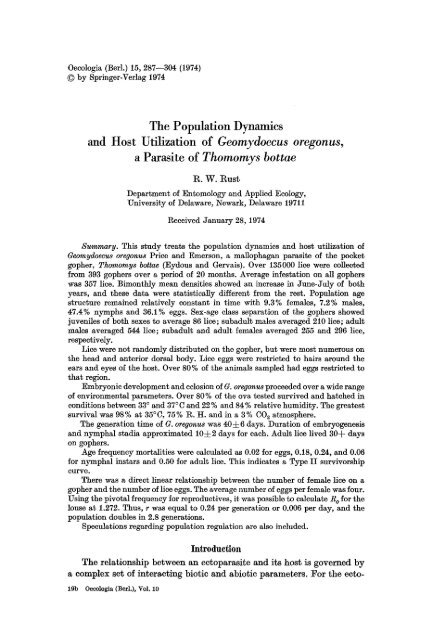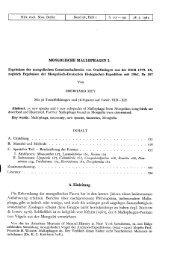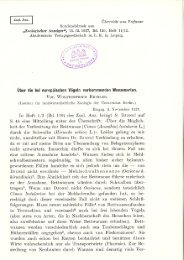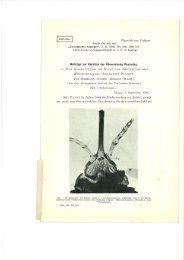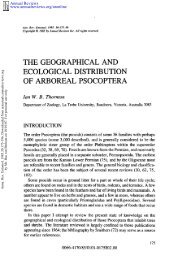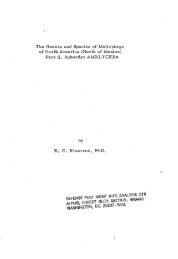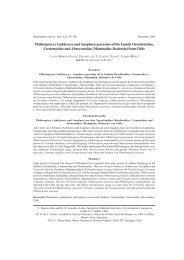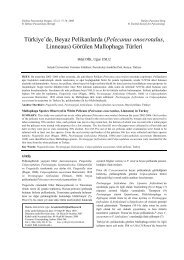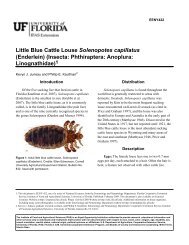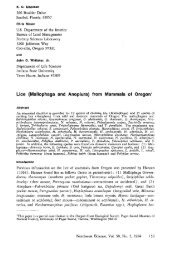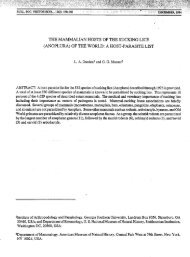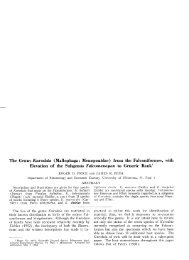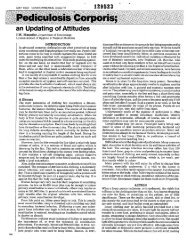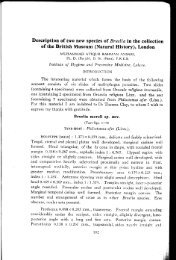The population dynamics and host utilization of ... - Phthiraptera
The population dynamics and host utilization of ... - Phthiraptera
The population dynamics and host utilization of ... - Phthiraptera
You also want an ePaper? Increase the reach of your titles
YUMPU automatically turns print PDFs into web optimized ePapers that Google loves.
Oecologia (Berl.) 15, 287--304 (1974)<br />
9 by Springer-Verlag 1974<br />
<strong>and</strong><br />
<strong>The</strong> Population Dynamics<br />
Host Utilization <strong>of</strong> Geomydoecus oregonus,<br />
a Parasite <strong>of</strong> Thomomys bottae<br />
R. W. Rust<br />
Department <strong>of</strong> Entomology <strong>and</strong> Applied Ecology,<br />
University <strong>of</strong> Delaware, Newark, Delaware 19711<br />
Received January 28, 1974<br />
Summary. This study treats the <strong>population</strong> <strong>dynamics</strong> <strong>and</strong> <strong>host</strong> <strong>utilization</strong> <strong>of</strong><br />
Geomydoecus oregonus Price <strong>and</strong> Emerson, a mallophagan parasite <strong>of</strong> the pocket<br />
gopher, Thomomys bottae (Eydous <strong>and</strong> Gervais). Over 135000 lice were collected<br />
from 393 gophers over a period <strong>of</strong> 20 months. Average infestation on all gophers<br />
was 357 lice. Bimonthly mean densities showed an increase in June-July <strong>of</strong> both<br />
years, <strong>and</strong> these data were statistically different from the rest. Population age<br />
structure remained relatively constant in time with 9.3% females, 7.2% males,<br />
47.4% nymphs <strong>and</strong> 36.1% eggs. Sex-age class separation <strong>of</strong> the gophers showed<br />
juveniles <strong>of</strong> both sexes to average 86 lice; subadult males averaged 210 lice; adult<br />
males averaged 544 lice; subadult <strong>and</strong> adult females averaged 255 <strong>and</strong> 296 lice,<br />
respectively.<br />
Lice were not r<strong>and</strong>omly distributed on the gopher, but were most numerous on<br />
the head <strong>and</strong> anterior dorsal body. Lice eggs were restricted to hairs around the<br />
ears <strong>and</strong> eyes <strong>of</strong> the <strong>host</strong>. Over 80% <strong>of</strong> the animals sampled had eggs restricted to<br />
that region.<br />
Embryonic development <strong>and</strong> eelosion <strong>of</strong> G. oregonus proceeded over a wide range<br />
<strong>of</strong> environmental parameters. Over 80% <strong>of</strong> the ova tested survived <strong>and</strong> hatched in<br />
conditions between 33 ~ <strong>and</strong> 37~ <strong>and</strong> 22 % <strong>and</strong> 84 % relative humidity. <strong>The</strong> greatest<br />
survival was 98% at 35~ 75% R. H. <strong>and</strong> in a 3% COs atmosphere.<br />
<strong>The</strong> generation time <strong>of</strong> G. oregonus was 40• days. Duration <strong>of</strong> embryogenesis<br />
<strong>and</strong> nymphal stadia approximated 10• days for each. Adult lice lived 30-t- days<br />
on gophers.<br />
Age frequency mortalities were calculated as 0.02 for eggs, 0.18, 0.24, <strong>and</strong> 0.06<br />
for nymphal instars <strong>and</strong> 0.50 for adult lice. This indicates a Type II survivorship<br />
curve.<br />
<strong>The</strong>re was a direct linear relationship between the number <strong>of</strong> female lice on a<br />
gopher <strong>and</strong> the number <strong>of</strong> lice eggs. <strong>The</strong> average number <strong>of</strong> eggs per female was four.<br />
Using the pivotal frequency for reproduetives, it was possible to calculate R o for the<br />
louse at 1.272. Thus, r was equal to 0.24 per generation or 0.006 per day, <strong>and</strong> the<br />
<strong>population</strong> doubles in 2.8 generations.<br />
Speculations regarding <strong>population</strong> regulation are also included.<br />
Introduction<br />
<strong>The</strong> relationshi p between an ectoparasite <strong>and</strong> its <strong>host</strong> is governed by<br />
a complex set <strong>of</strong> interacting biotic <strong>and</strong> abiotie parameters. For the ecto-<br />
1913 Oecologia (Bet1.), Vol. 10
288 R.W. Rust<br />
parasite, the biotic parameters are in general related to or originate from<br />
the <strong>host</strong>. <strong>The</strong> degree <strong>of</strong> adaptation <strong>of</strong> the parasite to the biotic parameters<br />
corresponds to the <strong>host</strong> specificity <strong>of</strong> the parasite. <strong>The</strong> degree <strong>of</strong> <strong>host</strong><br />
specificity also indicates the adaptations <strong>of</strong> the parasite to the abiotie<br />
parameters influencing the <strong>host</strong>. Mallophaga, biting lice, are <strong>host</strong> specific<br />
(Hopkins, 1949; Werneck, 1950), <strong>and</strong> the restriction <strong>of</strong> all life stages to<br />
the body <strong>of</strong> the <strong>host</strong> refines the specificity <strong>and</strong> adaptations <strong>of</strong> a louse to<br />
its <strong>host</strong> <strong>and</strong> <strong>host</strong>'s environment (see Clay, 1949; Ash, 1960; Baum, 1968;<br />
Foster, 1969, for avian lice; Ewing, 1924; Hopkins, 1949; Waterhouse,<br />
1953; Craufurd-Benson, 1941; Scott, 1952; Murray, 1957b-d, 1965;<br />
Hopkins <strong>and</strong> Chamberlain, 1969, for mammalian lice). For lice, the<br />
combination <strong>of</strong> interacting mortality factors <strong>and</strong> a species innate capacity<br />
for increase will determine the <strong>population</strong> level on a particular <strong>host</strong>.<br />
Evans <strong>and</strong> Smith (1952), in their classic demographic analysis <strong>of</strong> Pedi.<br />
culus humanus Linnaeus, were the first to study the reproductive potentials<br />
<strong>of</strong> an ectoparasite. Murray <strong>and</strong> Gordon (1969) modeled the <strong>population</strong><br />
<strong>dynamics</strong> <strong>of</strong> Bovicola ovis (Linnaeus), a biting louse <strong>of</strong> sheep. <strong>The</strong>y<br />
showed mathematically the development <strong>of</strong> the <strong>population</strong> from a low<br />
summer density to a winter high density.<br />
<strong>The</strong> genus Geomydoecus, parasites <strong>of</strong> the fossorial rodent family<br />
Geomyidae, possesses morphological adaptations not found in other<br />
trichodectid lice (Ewing, 1936). Degenerate adaptations as the absence<br />
<strong>of</strong> eyes <strong>and</strong> lack <strong>of</strong> abdominal spiracles <strong>and</strong> tergites might be a response<br />
to the altered conditions <strong>of</strong> the <strong>host</strong>'s burrow environment (Kennerly,<br />
1964; McNab, 1966; Darden, 1970), <strong>and</strong> specializations <strong>of</strong> the antennae<br />
<strong>and</strong> well-developed hair-groove could relate to life on the gopher. Recently,<br />
Price <strong>and</strong> Emerson (1971) studied Geomydoecus <strong>and</strong> found 45 taxa<br />
on 29 <strong>of</strong> the 36 species <strong>of</strong> gophers. Most gophers have only one louse<br />
species; exceptions were <strong>host</strong>s with extensive geographical distributions.<br />
<strong>The</strong> relative accessibility, small size, <strong>and</strong> peculiar habitat <strong>of</strong> the <strong>host</strong><br />
provide a system for analyzing a parasite's <strong>population</strong> <strong>dynamics</strong>. Thus,<br />
Geomydoecus oregonus Price <strong>and</strong> Emerson, a parasite <strong>of</strong> Thomomys bottae<br />
(Eydoux <strong>and</strong> Gervais), was selected for analysis <strong>and</strong> interpretation.<br />
Methods <strong>and</strong> Materials<br />
Field<br />
A minimum <strong>of</strong> 20 pocket gophers per month as live-trapped from two irrigated<br />
alfaHa fields located on the University <strong>of</strong> California, Davis Farm, <strong>and</strong> 2 consecutive<br />
months <strong>of</strong> collection data were combined for analysis. <strong>The</strong> field sizes, agricultural<br />
practices, measurement <strong>of</strong> environmental parameters, gopher collecting <strong>and</strong> laboratory<br />
h<strong>and</strong>ling techniques <strong>and</strong> parasite recovery methods are treated in Rust<br />
(1973a, b).<br />
Three age classes were established for both sexes <strong>of</strong> gophers: juvenile, subadult<br />
<strong>and</strong> adult. Separation was based on reproductive condition, skull features, <strong>and</strong> body
Population Dynamics <strong>of</strong> the Gopher Louse 289<br />
measurements (Miller, 1946, 1962; Hansen, 1960; Thaeler, 1968). Juveniles had the<br />
following sutures unfused: parietal-squamosal, maxilla-alisphenoid, <strong>and</strong> alisphenoidsquamosal;<br />
the dorsal surface <strong>of</strong> the maxilla (in the zygomatic arch) <strong>and</strong> palatine<br />
showed distinct porosity. Juveniles had gray pelage <strong>and</strong> were still in association<br />
with their mother, as determined from trapping. Subadults had partial fusion <strong>of</strong> the<br />
cranial sutures, reduced porosity <strong>and</strong> brownish pelage. Subadult females had a<br />
closed pubic symphysis <strong>and</strong> limited follicular development; subadult male testes<br />
were only 3-6 mm long. Adults had skull sutures <strong>and</strong> nonporous bones. Adult<br />
females had the pubic symphysis open, placental scars, embryos, or were lactating.<br />
Adult males had testes from 7-15 mm long. Body length <strong>and</strong> maximum skull length<br />
<strong>and</strong> width showed overlap due to a continuous breeding <strong>population</strong> (Miller, 1946)<br />
but were also used in the separation.<br />
Time for the age categories would be approximately one <strong>and</strong> one-half to two<br />
months for juveniles, 2-5 months for subadults <strong>and</strong> the mean length <strong>of</strong> life for adult<br />
gophers has been estimated by Howard <strong>and</strong> Childs (1959) as 7.6 months for males<br />
<strong>and</strong> 12.3 months for females.<br />
Laboratory<br />
Eelosion <strong>and</strong> first instar survival in vitro were examined under various environmental<br />
conditions. 8 different temperatures (27-41~ were maintained in Percival<br />
environmental chambers. <strong>The</strong> chambers were set for total darkness with the<br />
photophase only when eggs or nymphs were checked. Eight different relative<br />
humidities (10-96%)were maintained in liter desiccator jars containing various<br />
saturated salt solutions (Winston <strong>and</strong> Bates, 1960). Eclosion was tested in normal<br />
air <strong>and</strong> a 3% COz atmosphere. <strong>The</strong> high CO 2 atmosphere was created by removing<br />
3 % <strong>of</strong> the gas volume from the jars <strong>and</strong> replacing it with CO 2. <strong>The</strong> CO 2 concentration<br />
was measured with a Unieo Gas Analyzer.<br />
Four replicates <strong>of</strong> 25 eggs each were tested at 64 different temperature-relative<br />
humidity combinations. Translucent eggs were plucked individually from gophers<br />
for the temperature-relative humidity tests. Eclosion <strong>and</strong> nymphal survival in 3%<br />
CO 2 atmosphere were recorded at 33 ~ <strong>and</strong> 35~ both at 62%, 75% <strong>and</strong> 84% R. It.<br />
Nymphal survival was also checked in normal CO 2 atmosphere.<br />
<strong>The</strong> duration <strong>of</strong> embryonic development was obtained by allowing female lice<br />
to oviposit in small petri dishes. This gave eggs <strong>of</strong> a known age (-4-12 h), <strong>and</strong> these<br />
eggs were placed in separate containers in various temperature-relative humidity<br />
conditions.<br />
Louse survival on the <strong>host</strong> was checked in a normal CO 2 atmosphere at various<br />
humidities. Humidities tested were 35 % • 5, 50 % =J: 5, 75 % • 5 <strong>and</strong> 100 % -- 2 <strong>and</strong><br />
were maintained in environmental chambers at 21~1771.<br />
Louse demography was studied (in rive) in an artificial burrow system simulating<br />
natural conditions (Darden, 1970). Four artificial burrows were housed in<br />
adjoining chambers in a soil box (60.9 X 91.4 X 121.9 cm). Burrows were constructed<br />
<strong>of</strong> 7 • 7 mm hardware cloth welded together. A system consisted <strong>of</strong> an above ground<br />
holding cage (14.2 • 20.3 X 30.4 ore), an initial diagonal tunnel (30 cm), a horizontal<br />
tunnel (24 cm) <strong>and</strong> a nest chamber (19x24 era). <strong>The</strong> tunnels were 7.5 cm in diameter.<br />
Before an animal was placed in a burrow system, carrot pieces <strong>and</strong> fresh<br />
alfalfa were placed in the next chamber. <strong>The</strong> system was packed with soil <strong>and</strong><br />
buried in the soil box, with 25 to 30 em <strong>of</strong> soil over the nest chamber. <strong>The</strong> surface<br />
was moistened with approximately 2 1 <strong>of</strong> water <strong>and</strong> allowed to st<strong>and</strong> for 24 h before<br />
a gopher was introduced. Additional fresh alfalfa was provided daily. Two Plexiglas<br />
tubes (6 mm O. D.) were attached to the ro<strong>of</strong> <strong>of</strong> the nest chamber <strong>and</strong> horizontal<br />
tunnel. Both gas samples <strong>and</strong> temperatures were measured via the tubes. <strong>The</strong> entire<br />
system was housed in a greenhouse with a regime <strong>of</strong> controlled temperature <strong>and</strong>
290 R.W. Rus~<br />
natural light. Every seventh day <strong>of</strong> an experiment an additional 21 <strong>of</strong> water were<br />
added to the surface.<br />
Two different treatments were designed for gophers placed in the artificial<br />
system. Newly eclosed first instar nymphs were introduced on a clean gopher, <strong>and</strong><br />
the animal was released in a system for a set period--6, 10, 15, 20, 25, <strong>and</strong> 30 days.<br />
Freshly caught gophers were cleaned <strong>of</strong> parasites, empty lice eggs were plucked<br />
from the animal, <strong>and</strong> the remaining lice eggs were counted <strong>and</strong> mapped. <strong>The</strong>se<br />
animals were released in a system for 20, 30 <strong>and</strong> 40 days. At the end <strong>of</strong> an experiment,<br />
the animal was sacrificed <strong>and</strong> cleaned.<br />
Statistical analyses used in this study were Student's t-test, linear regression <strong>and</strong><br />
correlation, single class analysis <strong>of</strong> variance <strong>and</strong> curvilinear regression.<br />
Results<br />
Macro- <strong>and</strong> Microenvironmental Parameters<br />
During this study, average monthly temperatures varied from a low<br />
<strong>of</strong> 3.3~ in winter to a high <strong>of</strong> 25.4~ in summer. <strong>The</strong> Davis weather<br />
station mean maximum temperatures were 16.2 ~ <strong>and</strong> 30.2~ <strong>and</strong> the<br />
mean minima were 5.1 ~ <strong>and</strong> 11.8~ in winter <strong>and</strong> summer, respectively.<br />
Average monthly precipitation was from a high <strong>of</strong> 61.5 mm in winter<br />
months to 1 mm in summer months. Average monthly soil temperatures<br />
at 101 mm depth ranged from a low <strong>of</strong> 7.2~ in January to a high <strong>of</strong><br />
32.3~ in July. <strong>The</strong> soil moisture averaged 6.6% in winter <strong>and</strong> 5.3% in<br />
summer. <strong>The</strong> high summer soil moisture level was maintained by irrigation.<br />
<strong>The</strong> alfalfa fields were flood-irrigated at approximately 30-day<br />
intervals from April to September, with water covering the fields, except<br />
irrigation levees, for nearly 24 h.<br />
<strong>The</strong> relative humidity <strong>of</strong> the burrow measured 97.4• (N-=96).<br />
Kennerly (1964), McSTab (1966), <strong>and</strong> Darden (1970) also recorded the<br />
near saturated atmosphere <strong>of</strong> the gopher burrow. Darden (1970) determined<br />
that the CO S concentration <strong>of</strong> the gopher burrow averaged 2.3 %,<br />
<strong>and</strong> 03 averaged 18%. MeNab (1966) found an average CO S concentration<br />
<strong>of</strong> 1.4 % in the burrow <strong>of</strong> Geomys pinetis Rafinesque, <strong>and</strong> Kennerly<br />
(1964) measured only 0.8 % CO S in Geomys bursarius (Shaw) burrows. <strong>The</strong><br />
burrow temperatures showed less fluctuation than ambient temperatures<br />
<strong>and</strong> were out <strong>of</strong> phase with them. Rust (1973b) showed the relationship<br />
between ambient <strong>and</strong> burrow temperatures at two extreme times,<br />
August <strong>and</strong> January.<br />
In the artificial burrow system, the nest chamber temperature<br />
averaged 20.5-V0.6~ C (N-=30) <strong>and</strong> the CO S concentration was 2.4-4-0.1%<br />
(N=24). <strong>The</strong> soil moisture averaged 6.2% <strong>and</strong> ranged from 7.2% to<br />
4.1%. <strong>The</strong> greenhouse temperature was maintained between 14.4 ~ <strong>and</strong><br />
25.0 ~ C. Thus, the conditions for experimentation are considered similar<br />
to those that would be found in a natural burrow system, except during<br />
the cooler winter months.
Population Dynamics <strong>of</strong> the Gopher Louse 291<br />
Population Density <strong>and</strong> Structure<br />
Over 135000 Geomydoecus oregonus were removed from the gophers;<br />
5 animals were clean <strong>of</strong> lice. <strong>The</strong> average infestation for all gophers was<br />
357.5q-13.9 lice, <strong>and</strong> 1941 was the maximum number <strong>of</strong> lice recovered<br />
from an adult. Five other gophers (2 females <strong>and</strong> 3 males) had more than<br />
1000 lice on them. <strong>The</strong> bimonthly mean densities (Fig. 1) showed an<br />
increase in June-July <strong>of</strong> both years, <strong>and</strong> these sample means were found<br />
to be statistically different from the rest (F=2.7417, P~0.005). <strong>The</strong> 15<br />
"dry l<strong>and</strong>" gophers from August-September 1971 had a mean density <strong>of</strong><br />
376.1-~66.4 lice. This was not found to be significantly different from the<br />
mean <strong>of</strong> the "irrigated l<strong>and</strong>" sample for the same period or the overall<br />
mean (t=0.4253, 0.9~P ~0.5 <strong>and</strong> t=0.2709, 0.9~P~0.5, respectively).<br />
<strong>The</strong> <strong>population</strong> age structure remained relatively constant in time with<br />
9.3% females, 7.2% males, 47.4% nymphs <strong>and</strong> 36.1% eggs (Fig. 1).<br />
Juveniles had an increased proportion <strong>of</strong> eggs (44.8) <strong>and</strong> reduced nymphs<br />
(36.2), but adults were nearly equal. Geomydoecus oregonus has three<br />
nymphal instars as determined from head capsule measurements <strong>and</strong><br />
increased number <strong>of</strong> abdominal setae. <strong>The</strong> proportion <strong>of</strong> the nymphs<br />
represented by each was 19.9% first, 13.3% second <strong>and</strong> 14.2% third.<br />
1Vlean louse <strong>population</strong>s on male <strong>and</strong> female gophers were strikingly<br />
different with males averaging over 430 <strong>and</strong> females under 290. Further<br />
analysis <strong>of</strong> the <strong>population</strong> based on gopher age classes <strong>of</strong> juvenile, subadult,<br />
<strong>and</strong> adult revealed a greater difference. Juvenile gophers (N~--18),<br />
regardless <strong>of</strong> sex, averaged only 86.3~ 13.7 lice. Subadult males (N=46)<br />
had 210.8~19.8 lice, <strong>and</strong> adult males (N----120) averaged 544.2-~25.6.<br />
However, subadult (2V=71) <strong>and</strong> adult females (N----123) averaged nearly<br />
the same number <strong>of</strong> lice 255.0q-26.3 <strong>and</strong> 296.0• respectively. <strong>The</strong><br />
bimonthly sex-age class averages are plotted in Fig. 2.<br />
When the sex-age class averages are considered, the seasonal changes<br />
are at most slight although when combined, they show a statistically<br />
significant increase in June-July. This early summer increase in 1970 was<br />
a result <strong>of</strong> large louse <strong>population</strong>s on adult male gophers with 8 <strong>of</strong> 10<br />
having over 600 lice. <strong>The</strong> 1971 louse increase resulted from an increase in<br />
both adult female <strong>and</strong> subadult <strong>population</strong>s. Three <strong>of</strong> the adult females<br />
had over 800 lice, which if removed from the sample, reduces the mean<br />
to 299.<br />
Lice were not r<strong>and</strong>omly distributed on the gophers, but were most<br />
numerous on the head <strong>and</strong> anterior dorsal body. Selective cleaning<br />
produced the following distribution <strong>of</strong> lice: 19.7% dorsal head, 14.0%<br />
ventral head, 49.5% anterior dorsal body, 7.5% posterior dorsal body<br />
<strong>and</strong> 9.3 % ventral body. Lice on the ventral body were restricted to the<br />
area between the forelegs <strong>and</strong> axillae. If the above were based on the
292 R. W. Rust<br />
600<br />
5OO<br />
9 g~ ~ 400<br />
~300<br />
2OO<br />
I<br />
Nymphs<br />
6O<br />
5O<br />
40<br />
.... ~ ~ "'"~"~ 30<br />
20<br />
Females 10<br />
-- Males<br />
A-IM J'-J A:S O'-N D% F'-M A:M J:J A'-S O'-N<br />
Months<br />
Fig. 1. Population structure <strong>of</strong> Geomydoecus oregonus from 378 Thomomys bottae<br />
collected from Davis, California, from April 1970 through November 1971. Left <strong>and</strong><br />
above: mean <strong>population</strong> density for all gophers, vertical lines equal st<strong>and</strong>ard error.<br />
Right <strong>and</strong> below: <strong>population</strong> age structure<br />
800<br />
700<br />
600<br />
5OO<br />
~ 400<br />
g<br />
300<br />
200<br />
100<br />
Adutt Femc~le ~/"/'x"-,<br />
/, x,<br />
X ,,... ~<br />
~ ~ ? "',",~"- "......... 7~ "".......<br />
..~" " Subadu[[ Mole<br />
Mean Juvenile<br />
A"M J"J A~S ' O"N D~'J F~'M AIM J.J A"S O~'N<br />
Months<br />
:Fig. 2. Mean <strong>population</strong> density <strong>of</strong> Geomydoecus oregonus based on sex-age class<br />
separation <strong>of</strong> Thomomys bottae. Juvenile gophers represented by overall mean only
Population Dynamics <strong>of</strong> the Gopher Louse 293<br />
Fig. 3. Distribution <strong>of</strong> Geomydoecus oregonus eggs on 89 Thomomys bottae, above.<br />
Mean regional body temperatures in degrees centigrade, below<br />
proportion <strong>of</strong> the gopher's body inhabited, then 92.5 % <strong>of</strong> the lice were<br />
found on 55 % <strong>of</strong> the animal's surface.<br />
Egg Distribution, Numbers <strong>and</strong> Environmental Tolerance<br />
Distribution <strong>of</strong> the lice eggs was more restricted than thedistribution<br />
<strong>of</strong> nymphs <strong>and</strong> adults. <strong>The</strong> proportional distribution <strong>of</strong> eggs on 89 gophers<br />
is shown in Fig. 3. Over 80 % <strong>of</strong> the gophers had lice eggs located around<br />
the ears <strong>and</strong> eyes. If juvenile animals <strong>and</strong> adults with high infestations<br />
(800q-lice) were removed from the sample, the lice eggs on the mid-dorsal<br />
back were excluded from the distribution. An egg <strong>of</strong> G. oregonus is glued<br />
to the base <strong>of</strong> the hairs from one follicle <strong>and</strong> only one egg]hair group was<br />
observed. Although oviposition was not observed, the placement <strong>of</strong> the<br />
egg on the hairs suggests an oviposition behavior similar to that described<br />
for other lice (Murray, 1957a). <strong>The</strong> chorion remains attached after<br />
eclosion <strong>and</strong> until the hair group is shed with the subsequent molt.<br />
<strong>The</strong>re was a direct linear relationship (Fig. 4) between the number <strong>of</strong><br />
female lice on a gopher <strong>and</strong> the number <strong>of</strong> lice eggs (bz3.253=k0.208),<br />
with a correlation <strong>of</strong> 0.868. Thus 74% <strong>of</strong> the egg variation was explained<br />
by the presence <strong>of</strong> the female lice (r~=0.7396). <strong>The</strong> average number <strong>of</strong><br />
eggs per female was 4 (3.93) <strong>and</strong> ranged from 0.6 to 11.2. If juveniles,<br />
females with litters, <strong>and</strong> old gophers were removed, the range was<br />
narrowed to 2.9 to 8.2 eggs/female. In terms <strong>of</strong> eggs per day, G. oregonus<br />
lays 0.2 eggs/day in an average life span.
294 R.W. Rust<br />
400 .', 9 ' '"<br />
9 ~6<br />
350<br />
3oo<br />
~" 250<br />
0<br />
~200 ....<br />
0<br />
-' 100 , ,,,-/:," , , r =0.868<br />
n 89<br />
50 ~.~, ," "~.X, ,: , : ,<br />
, _ , , , , , ,<br />
20 40 60 80 100 120 140<br />
Female Lice per Gopher<br />
Fig. 4. Regression <strong>of</strong> number <strong>of</strong> female Geomydoecus oregonus per Thomomys bo#ae<br />
to number <strong>of</strong> G. oregonus eggs per gropher<br />
Embryonic development <strong>and</strong> eclosion <strong>of</strong> G. oregonus proceeded over a<br />
wide range <strong>of</strong> environmental parameters. An 80 % or greater plateau <strong>of</strong> ova<br />
survival <strong>and</strong> hatching (Fig. 5) was found between 33-37~ <strong>and</strong> 22-84%<br />
relative humidity. <strong>The</strong> greatest survival was 96% at 35~ <strong>and</strong> 75% R. It.<br />
<strong>The</strong> mean rectal temperature <strong>of</strong> T. bottae was 36.5~0.4~ (N=26).<br />
Darden (1970) recorded an average <strong>of</strong> 36.7~ for the same species. This<br />
temperature was near the upper end <strong>of</strong> the survival range. However,<br />
surface temperatures (Fig. 3) <strong>of</strong> the cheek <strong>and</strong> head region were approximately<br />
1~ lower <strong>and</strong> corresponded to the highest eclosion rate.<br />
Development <strong>and</strong> hatching occurred in 3 % CO 2 atmosphere <strong>and</strong> with<br />
a slightly higher survival rate than eggs reared in a normal CO S atmosphere.<br />
Ninety-eight percent <strong>of</strong> over 500 eggs hatched in vitro <strong>and</strong><br />
97.7% <strong>of</strong> the eggs hatched on gophers in the artificial burrow system.<br />
Darden (1970) determined the CO s concentration <strong>of</strong> the gopher burrow<br />
to average 2.3 %, <strong>and</strong> O 3 averaged 18 %. I found an average CO 2 concentration<br />
<strong>of</strong> 2.4% in the nest chamber <strong>of</strong> the artificial burrow system.<br />
Normal atmospheric CO 2 was determined to slightly reduce the survival<br />
<strong>of</strong> the louse. Eggs on 3 gophers maintained in normal atmosphere <strong>and</strong><br />
exposed to a relative humidity greater than 75 % for 30 days hatched <strong>and</strong><br />
developed to third instar <strong>and</strong> adult lice with an average mortality <strong>of</strong><br />
56.3%.
Population Dynamics <strong>of</strong> the Gopher Louse 295<br />
100 100<br />
m "U<br />
zs<br />
zs<br />
D -I<br />
50 50 C<br />
| .7<br />
U ~.<br />
D- e~<br />
25 25<br />
~'/<br />
qb<br />
Fig. 5. Survival <strong>and</strong> eclosion <strong>of</strong> Geomydoecus oregonus eggs reared in vitro under<br />
constant temperature <strong>and</strong> relative humidity<br />
Population Development<br />
<strong>The</strong> embryonic development <strong>of</strong> G. oregonus averaged 10.5days<br />
(N=18) <strong>and</strong> ranged from 9 to 12 days. This time plus the duration <strong>of</strong><br />
nymphal development (Table 1) indicates a generation time <strong>of</strong> 40=k6<br />
days. Duration <strong>of</strong> nymphal stadia approximated 10• days for each.<br />
<strong>The</strong> longevity <strong>of</strong> adult lice was not ascertained. However, 6 females <strong>and</strong><br />
3 males out <strong>of</strong> a total <strong>of</strong> 80 lice lived 30~-days on gophers in the<br />
artificial burrow system.<br />
<strong>The</strong> mortality rate (Table 1) from cohorts beginning with first instar<br />
lice was extremely high as indicated by a 50 % mortality <strong>of</strong> first instar<br />
lice after 6 days. This high death rate was probably induced by h<strong>and</strong>ling
296 R.W. Rust<br />
Table 1. Recovery <strong>of</strong> Geomydoecus oregonus from gophers, each artificially infested<br />
with newly hatched first instar nymphs. Gophers maintained in artificial burrows<br />
Days Inoc- I~umber <strong>and</strong> stage <strong>of</strong> development Total %<br />
after ulum Mortality<br />
infesta- Immatures Adults<br />
tion 1st 2nd 3rd ~<br />
6 36 18 . . . . 18 50.0<br />
10 58 1 16 -- -- -- 17 70.3<br />
15 49 -- 8 1 -- -- 9 81.7<br />
20 32 -- 2 2 -- -- 4 87.5<br />
25 31 -- -- 2 -- -- 2 93.5<br />
30 40 -- -- -- 2 1 3 90.0<br />
the lice <strong>and</strong> a delay (12 h) before they could feed or assume a correct<br />
posture on the gopher. <strong>The</strong> results (Table 2) obtained from cohorts<br />
starting with the egg stage, indicate a Type II survivorship curve for the<br />
louse <strong>population</strong>. Thus, age frequency mortalities can be calculated as<br />
0.02 for eggs, 0.18, 0.24, <strong>and</strong> 0.06 for the nymphal instars, <strong>and</strong> 0.50 for<br />
adult lice. Due to the 10 day age difference <strong>of</strong> eggs used to initiate these<br />
tests, females <strong>and</strong> new eggs were already present on the gophers in the<br />
30 day samples, <strong>and</strong> at 40 days, new first instar lice appeared in the<br />
samples. Using the pivotal frequency for reproductives, it is possible to<br />
estimate the net reproductive rate, Ro=Zlxm x. Thus, R o for G. oregonus<br />
is 1.272 (0.53 X 2.4= 1.272). This assumes a 1:1.2 sex ratio, equal survival<br />
<strong>of</strong> sexes <strong>and</strong> an average <strong>of</strong> 4 eggs per female louse. <strong>The</strong> intrinsic rate <strong>of</strong><br />
increase (r) can be calculated from Ro=e% Thus, r is equal to 0.24 per<br />
generation or 0.006 per day, <strong>and</strong> the <strong>population</strong> doubles in 2.8 genera-<br />
tions.<br />
Duration<br />
days<br />
Table 2. Recovery <strong>of</strong> Geomydoecu8 oregonus from gophers, each naturally infested<br />
with eggs. Gophers maintained in artificial burrow systems<br />
Num- Inoc- Number <strong>and</strong> stage <strong>of</strong> development Mortality<br />
ber<br />
<strong>of</strong><br />
ulum<br />
eggs Immatures Adults Eggs % %<br />
gophers eggs total<br />
1st 2nd 3rd ~ !~ Unhatched new<br />
%a<br />
age<br />
interval<br />
20<br />
30<br />
40<br />
2 295 65 127 34 7 -- 2.3 20.0<br />
4 551 -- 7 187 42 43 11 21 1.9 49.4<br />
5 914 13 b -- 30 150 180 ? 157 ? 60.7<br />
a Determined initially from 2 % egg mortality <strong>and</strong> rounded to nearest whole number.<br />
b First instars <strong>of</strong> second generation.<br />
18.0<br />
30.0<br />
ll.0
Population Dynamics <strong>of</strong> the Gopher Louse 297<br />
Discussion<br />
Population Structure <strong>and</strong> Development<br />
C<strong>of</strong>fman (personal communication) studied Geomydoecus geomydis<br />
(Osborn), a parasite <strong>of</strong> Geomys bursarius. He found nearly twice the mean<br />
density <strong>of</strong> lice as I did for G. oregonus as well as a seasonal shift with a<br />
spring increase for G. geomydis in South Dakota. Geomys bursarius is one<br />
<strong>and</strong> one-half to two times as large (body weight) as T. bottae from the<br />
Davis area (Hall <strong>and</strong> Kelson, 1959), breeds once a year, is subject to<br />
different climatic regimes <strong>and</strong> possibly different microenvironmental<br />
conditions such as lower CO S concentration (Kennerly, 1964). Size <strong>of</strong> <strong>host</strong><br />
(decreased surface area), continous breeding (Miller, 1946), the effects <strong>of</strong><br />
a different climatic regime, <strong>and</strong> flood irrigation are elements which<br />
probably reduce the <strong>population</strong> size <strong>of</strong> G. oregonus on T. bottae in the<br />
Davis area. Other trichodectid lice are found primarily on fissiped<br />
carnivores, hyraxes <strong>and</strong> ungulates (Hopkins, 1949; Emerson, 1964), <strong>and</strong><br />
seasonal fluctuations in other small mammal mallophagans are unknown<br />
to me. Large mammal mallophagan species show a general late fall to<br />
winter increase <strong>and</strong> a summer decline (Crauford-Benson, 1949 ; Matthysse,<br />
1944, 1946; Scott, 1952; Enzie, 1956; Murray, 1960, 1963a, b). Vysotoskaya<br />
(1950) <strong>and</strong> Murray (1961) have suggested that the fall to winter<br />
increase may relate to the <strong>host</strong>'s responses to the severity <strong>of</strong> the winter<br />
conditions. However, the general uniformity <strong>of</strong> G. oregonus <strong>population</strong><br />
structure through time may result from the modified summer environmental<br />
conditions brought about by irrigation. <strong>The</strong> homogenous conditions<br />
in irrigated l<strong>and</strong>s are also responsible for year-round reproduction<br />
<strong>of</strong> gophers (Miller, 1946). If the louse is affected by the environmental<br />
conditions in the late summer as is the <strong>host</strong> (Miller, 1946; Howard <strong>and</strong><br />
Childs, 1959), then a <strong>population</strong> decline may be predicted. <strong>The</strong> small<br />
"dry l<strong>and</strong>" sample mean, however, equalled the mean number on <strong>host</strong>s<br />
from irrigated l<strong>and</strong>s. Howard <strong>and</strong> Childs (1959) suggested that gophers<br />
may retreat to lower burrows <strong>and</strong> seal shallower ones to escape the<br />
summer heat. This could equalize environmental conditions <strong>and</strong> allow<br />
louse reproduction to proceed.<br />
<strong>The</strong> different louse densities on the sex-age classes <strong>of</strong> gophers result<br />
from at least two factors : the size <strong>of</strong> the animal <strong>and</strong> the loss <strong>of</strong> a portion<br />
<strong>of</strong> adult female's parasites to the young <strong>of</strong> each litter. Thus, the time <strong>of</strong><br />
maximum gopher reproduction would also be the most disruptive period<br />
for the lice on female gophers. <strong>The</strong> reduced mean density <strong>of</strong> lice on adult<br />
females in February-March is concomitant with maximum gopher<br />
reproduction (Miller, 1946), <strong>and</strong> the increased density <strong>of</strong> lice in the early<br />
winter months corresponds to minimum gopher reproduction. <strong>The</strong><br />
solitary habits <strong>of</strong> gophers (Ingles, 1952 ; Howard <strong>and</strong> Childs, 1959) suggest<br />
that the exchange <strong>of</strong> parasites takes place primarily between females with
298 1%. W. Rust<br />
litters <strong>and</strong> between litter mates. This explains the adult sex differences<br />
<strong>and</strong> small louse <strong>population</strong> (inoculum) on juvenile gophers. Miller (1946)<br />
found an average <strong>of</strong> 5 young/litter <strong>and</strong> 2 litters/year for gophers inhabiting<br />
irrigated fields in the Davis area. Thus, ideally 84% <strong>of</strong> the female's<br />
louse <strong>population</strong> could be lost twice a year. Actual measurements <strong>of</strong> the<br />
proportion <strong>of</strong> the <strong>population</strong> lost ranged from 56% to 66% for litter<br />
sizes <strong>of</strong> 2 <strong>and</strong> 4 (N=4).<br />
Lice are generally found on the head <strong>and</strong> foreparts <strong>of</strong> the small<br />
mammals <strong>and</strong> may spread over the dorsal <strong>and</strong> lateral aspects <strong>of</strong> the <strong>host</strong><br />
as the <strong>population</strong> increases (Vysotoskaya, 1950; Dubinin, 1953; Murray,<br />
1961). In general, louse distribution is controlled by the grooming<br />
characteristics <strong>of</strong> the <strong>host</strong> (Murray, 1961). Observations <strong>of</strong> gopher<br />
grooming indicate that lice can be nipped from the ventral body <strong>and</strong><br />
possibly the hind quarters. <strong>The</strong> short neck <strong>and</strong> large pectoral girdle<br />
prevent more extensive preening with incisors. Preening with the hind<br />
<strong>and</strong> fore claws in the form <strong>of</strong> scratching probably does not remove many<br />
lice because <strong>of</strong> their tenacity. This action could destroy stationary nits,<br />
but gophers were observed to rub the head region with their fore claws<br />
rather than scratch with claw tips.<br />
Preening is an important control agent in the distribution <strong>of</strong> nits<br />
(Murray, 1961), but hair size <strong>and</strong> configuration (Murray, 1957b-d;<br />
Hopkins <strong>and</strong> Chamberlain, 1969) <strong>and</strong> <strong>host</strong> regional body temperatures<br />
(Murray, 1957e, 1963b, 1965) also affect their distribution. Another<br />
factor on the gopher is the structure <strong>of</strong> the hairs on which eggs are glued.<br />
Most hair follicles on the gopher contain 9-18 hairs (Morejohn <strong>and</strong><br />
Howard, 1956), but the character <strong>of</strong> hairs per follicle differs in the<br />
various body regions. Hair follicles on the dorsal <strong>and</strong> lateral aspects <strong>of</strong><br />
the head bear 4-6 large guard hairs <strong>and</strong> 7-12 fur hairs, whereas follicles<br />
on the dorsal body lack the stiff guard hairs. Follicular separation is<br />
nearly equal over the body, with the hairs follicles being separated by<br />
0.25-0.33 ram. <strong>The</strong> response <strong>of</strong> female lice to a particular hair configuration<br />
for oviposition may result in the limited distribution as seen<br />
on over 80% <strong>of</strong> the gophers sampled. On juveniles, all hairs are <strong>of</strong> the<br />
fur type <strong>and</strong> thus the possible wider distribution <strong>of</strong> nits, but as the<br />
gopher loses its juvenile pelage the hair per follicle change to the fur<br />
hair-guard hair arrangement. <strong>The</strong> wider distribution <strong>of</strong> nits on gophers<br />
with large infestations (800-~) possibly indicates a spreading to less<br />
favorable sites.<br />
Molting restricts the availability <strong>of</strong> oviposition sites <strong>and</strong> may result<br />
in a loss <strong>of</strong> eggs already laid. Evidence for the latter is sparse, although<br />
Vysotoskaya (1950) considered molting a major factor for <strong>population</strong><br />
decline. Three gophers with active molt lines in <strong>and</strong> around the ears <strong>and</strong><br />
eyes had no unhatched nits in the area. When examined 30 days later the
Population Dynamics <strong>of</strong> the Gopher Louse 299<br />
molt line had moved posteriorly <strong>and</strong> the empty eggs were gone. Morejohn<br />
<strong>and</strong> Howard (1956) studied the molt patterns <strong>of</strong> captive <strong>and</strong> field gophers.<br />
<strong>The</strong>y found two distinct seasonal pelages, winter <strong>and</strong> summer, <strong>and</strong> a<br />
constant molt period with a short non-molt period from December to<br />
February. It is therefore possible to have a reduction in the hair follicles<br />
available twice a year. <strong>The</strong> dense replacement hairs <strong>and</strong> thickened dermis<br />
during active molting renders an area inaccessible to lice <strong>and</strong> oviposition.<br />
Lice were not observed in this thick, new hair.<br />
Using an average juvenile gopher inoculum <strong>of</strong> 86 lice <strong>and</strong> no upper<br />
restriction on <strong>population</strong> growth, the average mean density <strong>of</strong> lice on<br />
subadults can be reached in about 200 days <strong>and</strong> for adult males in 300<br />
days. <strong>The</strong> mean louse density <strong>of</strong> adult female gophers would also be<br />
reached in 200 days, <strong>and</strong> this represents an approximation <strong>of</strong> sexual<br />
maturity (Miller, 1946). On male gophers, the louse density would reach<br />
nearly 1000 in 400 days, which is the mean longevity <strong>of</strong> male gophers<br />
(I-Ioward <strong>and</strong> Childs, 1959). <strong>The</strong> small sample <strong>of</strong> gophers with 1000 or<br />
more lice suggests that factors must be operating to maintain the density<br />
at a lower level than predicted.<br />
To examine the <strong>population</strong> growth curve, an arbitrary measure <strong>of</strong> time<br />
was necessary because <strong>of</strong> the difficulty in accurate aging <strong>of</strong> gophers. <strong>The</strong><br />
measurement selected was the increase in surface area <strong>of</strong> the gopher<br />
(cm 2) <strong>and</strong> was obtained by combining body length <strong>and</strong> circumference <strong>of</strong><br />
the thorax cavity, legs <strong>and</strong> tail excluded from the measurement. An<br />
accuracy check was made by measuring fresh, fiat skins. It has been<br />
shown that gophers continue to grow as adults (Miller, 1952 ; Howard <strong>and</strong><br />
Chflds, 1959). <strong>The</strong>refore, a clumping <strong>of</strong> older animals in a younger age<br />
group is not expected.<br />
<strong>The</strong> average densities on categoric age groups showed nearly equal<br />
numbers <strong>of</strong> lice on subadult <strong>and</strong> adult female gophers. Thus, the louse<br />
<strong>population</strong> on a female gopher should reach an asymptote at some body<br />
size or point in time. <strong>The</strong> relationship between female gopher area <strong>and</strong><br />
lice per area was curvilinear (Fig. 6) <strong>and</strong> the curve was defined by a<br />
second degree polynomial, Y=--8.9990+O.15884X--O.OOO56X 2. On<br />
female gophers, the louse <strong>population</strong> leveled at 2.2 lice per cm ~ over<br />
140 cm 2 <strong>of</strong> body area, or 308 lice. <strong>The</strong> mean densites <strong>of</strong> lice on male<br />
gophers differed according to age groups, <strong>and</strong> the relationships were<br />
analyzed for both linear <strong>and</strong> eurvilinear regression. <strong>The</strong> test for curvilinear<br />
regression (Snedecor, 1956) was highly significant (F--~7.1604,<br />
P>0.001), <strong>and</strong> a linear relationship was rejected. <strong>The</strong> curve (Fig. 6) was<br />
defined by a second degree polynominal, Y------5.4723-~0.09352X--<br />
0.0026X 2. <strong>The</strong> louse <strong>population</strong> on male gophers leveled at around 2.9 lice<br />
per cm ~ over an area <strong>of</strong> 175 cm ~, or 507 lice. <strong>The</strong> respective asymptotes<br />
are equal to the overall mean densities for adult animals.
300 R. W. Rust<br />
%<br />
o.<br />
._J<br />
4<br />
3<br />
2<br />
Juveniles ..;'if"'" Female<br />
Adult Mate<br />
SubaduIt ..,.'J............................................<br />
Male ..,'": ............<br />
,.'..;~;:'~"~ j Adult Ferna[e<br />
4O<br />
, I " | , t I , i .... ,<br />
80 100 120 140 160 180 200<br />
Gopher Body Area (cm 2)<br />
Fig. 6. Population growth curve for Geomydoecus oregouus on male <strong>and</strong> female<br />
Thomomys bottae as determined from regression analysis <strong>of</strong> the relationship <strong>of</strong> the<br />
number <strong>of</strong> lice per body area to the total body area available<br />
Population Regulation<br />
Population growth as presented above can be controlled by both<br />
density dependent <strong>and</strong> density independent factors. Food is not considered<br />
to be an important factor, since it is in constant supply on the <strong>host</strong><br />
(Waterhouse, 1953). One dependent factor appears to be the availability<br />
<strong>of</strong> a proper oviposition site. This was indicated by the narrow distribution<br />
<strong>of</strong> nits on gophers <strong>and</strong> the inaccessibility <strong>of</strong> a site until the hairs<br />
were replaced. Cannibalism has been reported for avian mallophagans<br />
(Waterston, 1926; Rothschild <strong>and</strong> Clay, 1952; Nelson, 1971). Hopkins<br />
<strong>and</strong> Chamberlain (1969) found destruction <strong>of</strong> nits, as high as 25% in<br />
in vitro colonies <strong>of</strong> B. crass@es. I found no evidence for cannibalism in<br />
G. oregonus. Empty chorions on the gophers appeared intact <strong>and</strong> undamaged.<br />
Lice held in small containers for 5 days did not destroy or consume<br />
newly laid eggs or immature individuals. This does not, however, exclude<br />
the possibility <strong>of</strong> cannibalism for G. oregonus.<br />
Density independent factors such as preening, molting, <strong>and</strong> social<br />
interaction <strong>of</strong> the <strong>host</strong> can lead to <strong>population</strong> reduction or control.<br />
Environmental conditions in the Davis area <strong>and</strong> especially in irrigated<br />
fields do not appear to restrict the <strong>population</strong> densites. Irrigation may<br />
destroy a proportion <strong>of</strong> the <strong>population</strong> at the time <strong>of</strong> flooding. Wet<br />
gophers were found in the fields during the initial stages <strong>of</strong> irrigation, but<br />
more commonly, dry animals were found on field levees, murray (1963a)<br />
showed that adults <strong>and</strong> nymphs <strong>of</strong> B. ovis can survive immersion in
Population Dynamics <strong>of</strong> the Gopher Louse 301<br />
water for 1 h with less than 20 % mortality. Eggs could be immersed for<br />
up to 7 days before a substantial reduction in hatching occurred. It is<br />
therefore possible to have a reduction in the nymph <strong>and</strong> adult <strong>population</strong><br />
with each irrigation. <strong>The</strong> distribution <strong>of</strong> the lice on the gopher <strong>and</strong> the<br />
inability <strong>of</strong> the gopher to withst<strong>and</strong> immersion for even one hour probably<br />
reduces the severity <strong>of</strong> irrigation.<br />
Interaction <strong>and</strong> competition with other ectoparasites may influence<br />
the upper densities (Hopkins, 1949; Vysotoskaya, 1950). Geomydoecus<br />
oregonus co-inhabits the gopher in the Davis area with three other<br />
parasites (Rust, 1973 a, b). <strong>The</strong> small size <strong>and</strong> restricted distribution <strong>of</strong><br />
Geomylichus n. sp. <strong>and</strong> the nidicolous habits <strong>of</strong> Haemolaelaps geomys<br />
Str<strong>and</strong>tmann remove them from interactions with the louse (Rust,<br />
1973 b). Hirstionyssus ]emuralis Allred is found both in the nest <strong>and</strong> on the<br />
<strong>host</strong> in low numbers <strong>and</strong> are not considered to pose any serious deterrent<br />
in the louse density increase.<br />
Finally, the physiological state <strong>of</strong> the <strong>host</strong>, either environmentally or<br />
pathologically induced, may influence <strong>population</strong> size. Sick animals have<br />
been reported by several workers as having unusually heavy infestations<br />
<strong>of</strong> lice (Thompson, 1936; Spencer, 1939; Craufurd-Benson, 1941; <strong>and</strong><br />
Eichler, 1942). <strong>The</strong> state <strong>of</strong> health <strong>of</strong> the 6 gophers with heavy infestations<br />
could not be determined. However, they appeared healthy. <strong>The</strong><br />
only "unhealthy" animals encountered were wounded males, but this<br />
is probably a common condition resulting from their pugnacious behavior<br />
(Howard <strong>and</strong> Childs, 1959). Increased louse reproduction induced by<br />
ingestion <strong>of</strong> <strong>host</strong> hormones, as in the classical case <strong>of</strong> Spilopsyllus cuniculi<br />
Dale <strong>and</strong> its <strong>host</strong> the rabbit (Mead-Briggs <strong>and</strong> Rudge, 1960; Rothschild<br />
<strong>and</strong> Ford, 1964 a, b), is not considered important. <strong>The</strong> food <strong>and</strong> feeding<br />
habits <strong>of</strong> trichodectid lice (Waterhouse, 1953) would prevent contact with<br />
<strong>host</strong>'s blood. If estrogens enter the dermal tissue fluids, then they may be<br />
ingested <strong>and</strong> could then be considered an important factor.<br />
Acknowledgements. I thank K. Emerson <strong>and</strong> 1%. D. Price for their identification<br />
<strong>of</strong> Geomydoecus oregonus. 1%. F. Denno, D. L. McLean, R.W. Thorp <strong>and</strong> R.K.<br />
Washino read various stages <strong>of</strong> the manuscript. <strong>The</strong>ir criticisms <strong>and</strong> suggestions<br />
were appreciated. Charles C<strong>of</strong>fman provided unpublished data which was most<br />
helpful. Aileen K. Rust assisted throughout the study. Her comments <strong>and</strong> suggestions<br />
are sincerely appreciated.<br />
References<br />
Ash, J. S. : A study <strong>of</strong> the Mallophaga <strong>of</strong> birds with particular reference to their<br />
ecology. Ibis 120, 93-102 (1960)<br />
Bantu, H. :Biologie nnd Okologie der Amselfederl~use. Angew. Parasit. 9, 129-175<br />
(1968)<br />
Clay, T.: Some problems in the evolution <strong>of</strong> a group <strong>of</strong> eetoparasites. Evolution 3,<br />
279-299 (1949)<br />
20 Oeeologia (Berl.), Vol. 15
302 R.W. Rust<br />
Craufurd-Benson, H. J. : <strong>The</strong> cattle lice <strong>of</strong> Great Britain. Parasitology 88, 331-358<br />
(1941)<br />
Darden, T. R. : Respiratory adaptations <strong>of</strong> a fossorial mammal, the pocket gopher<br />
(Thomomys bottae). Unpublished Ph.D. Dissertation, Univ. California, Davis<br />
(1970)<br />
Dubinin, V. B.: Parasitic fauna <strong>of</strong> Murid rodents <strong>and</strong> its changes in the fauna <strong>of</strong> the<br />
Volga Delta. Parazit. Sbornik 15, 252-301 (1953)<br />
Eichler, W. : Die Entfaltungsregel und <strong>and</strong>ere Gesetzm~Bigkeiten in den parasitogenetischen<br />
Beziehungen der Mallophagen und <strong>and</strong>ere st~ndiger Parasiten zu<br />
ihren Wirten. Zool. Anz. 187, 77-83 (1942)<br />
Emerson, K. C.: Checklist <strong>of</strong> Mallophaga <strong>of</strong> North America (north <strong>of</strong> Mexico),<br />
p. 1-171. Dugway, Utah: Dugway Proving Grounds 1964<br />
Enzie, F.D.: Mange <strong>and</strong> lice <strong>of</strong> horses <strong>and</strong> mules. Yearbk. Agr. USDA 1956,<br />
555-558 (1956)<br />
Evans, :F. C., Smith, F. E.: <strong>The</strong> intrinsic rate <strong>of</strong> natural increase for human louse,<br />
Pediculus humanus L. Amer. Nat. 86, 299-310 (1952)<br />
Ewing, H. E. : On the taxonomy, biology <strong>and</strong> distribution <strong>of</strong> the biting lice <strong>of</strong> the<br />
family Gyropidae. U. S. Nat. Mus. Prec. 68, 1-42 (1924)<br />
Ewing, H. E.: <strong>The</strong> taxonomy <strong>of</strong> the mallophagan family Trichodeetidae, with<br />
special reference to the New World fauna. J. Parasit. 22, 233-246 (1936)<br />
Foster, M. S.: Synchronized life cycles in the Orange-crowned Warbler <strong>and</strong> its<br />
mallophagan parasites. Ecology 50, 315-323 (1969)<br />
Hall, E. R., Kelson, K. P.: <strong>The</strong> mammals <strong>of</strong> North America, Vol. 1. New York:<br />
Ronald Press 1959<br />
Hansen, R. M.: Age <strong>and</strong> reproductive characteristics <strong>of</strong> mountain pocket gophers<br />
in Colorado. J. Mamm. 41, 323-335 (1960)<br />
Hopkins, G. H. E. : <strong>The</strong> <strong>host</strong>-associations <strong>of</strong> the lice <strong>of</strong> mammals. Zool. Soc. London<br />
Prec. 119, 387-604 (1949)<br />
Hopkins, D. E., Chamberlain, W. F. : In vitro colonization <strong>of</strong> the goat biting lice,<br />
Bovicola crassipes <strong>and</strong> B. timbata. Ann. ent. See. Amer. 62, 826-828 (1969)<br />
Howard, W. E., Childs, H. E. : Ecology <strong>of</strong> pocket gophers with emphasis on <strong>The</strong>morays<br />
bottae mewa. Hilgardia 29, 277-358 (1959)<br />
Ingles, L. G. : <strong>The</strong> ecology <strong>of</strong> the mountain pocket gopher, Thomomys monticola.<br />
Ecology 88, 87-95 (1952)<br />
Kennerly, T. E.: Mieroenvironmental conditions <strong>of</strong> the pocket gopher burrow.<br />
Texas J. Sci. 16, 395~41 (1964)<br />
Matthysse, J. G. : Biology <strong>of</strong> the cattle biting louse <strong>and</strong> notes on cattle sucking lice.<br />
J. econ. Ent. 87, 436-442 (1944)<br />
Matthysse, J. G.: Cattle lice, their biology <strong>and</strong> control. New York State Agr. Exp.<br />
Sta. Ithaca Bull. 832 (1946)<br />
MeNab, B.K.: <strong>The</strong> metabolism <strong>of</strong> fossorial rodents: a study <strong>of</strong> convergence.<br />
Ecology 47, 712-733 (1966)<br />
Mead-Briggs, A. R., Rudge, A. J. B.: Breeding <strong>of</strong> the rabbit flea, Spilopsyllus<br />
cuniculi (Dale): Requirement <strong>of</strong> a "factor" from a pregnant rabbit for ovarian<br />
maturation. Nature (Lond.) 187, 1136 (1960)<br />
Miller, M. A.: Reproductive rates <strong>and</strong> cycles in the pocket gopher. J. Mamm. 27,<br />
335-358 (1946)<br />
Miller, M. A.: Size characteristics <strong>of</strong> the Sacramento Valley pocket gopher (Thomo.<br />
mys bottae marvus Merriam). J. Mamm. 83, 442-456 (1952)<br />
Morejohn, G.V., Howard, W. E.: :Holt in the pocket gopher, Thomomys bottae.<br />
J. Mamm. 37, 201-213 (1956)
Population Dynamics <strong>of</strong> the Gopher Louse 303<br />
Murray, M. D.: <strong>The</strong> distribution <strong>of</strong> the eggs <strong>of</strong> mammalian lice on their <strong>host</strong>s.<br />
I. Description <strong>of</strong> the oviposition behavior. Aust. J. Zool. 5, 13-18 (1957a)<br />
Murray, M. D.: <strong>The</strong> distribution <strong>of</strong> the eggs <strong>of</strong> mammalian lice on their <strong>host</strong>s.<br />
II. Analysis <strong>of</strong> the oviposition behavior <strong>of</strong> Damalinia ovis (L.). Aust. J. Zool. 5,<br />
19-29 (1957b)<br />
Murray, M. D.: <strong>The</strong> distribution <strong>of</strong> the eggs <strong>of</strong> mammalian lice on their <strong>host</strong>s.<br />
III. <strong>The</strong> distribution <strong>of</strong> the eggs <strong>of</strong> Damalinia ovis (L.) on the sheep. Aust. J.<br />
Zool. 5, 173-182 (1957c)<br />
Murray, M. D.: <strong>The</strong> distribution <strong>of</strong> the eggs <strong>of</strong> mammalian lice on their <strong>host</strong>s.<br />
IV. <strong>The</strong> distribution <strong>of</strong> the eggs <strong>of</strong> Damalinia equi (Denny) <strong>and</strong> Haematopinus<br />
asini (L.) on the horse. Aust. J. Zool. 5, 183-187 (1957d)<br />
Murray, M. D. : <strong>The</strong> ecology <strong>of</strong> lice on sheep. II. <strong>The</strong> influence <strong>of</strong> temperature <strong>and</strong><br />
humidity on the development <strong>and</strong> hatching on the eggs <strong>of</strong> Damalinia ovis (L.).<br />
Aust. J. Zoo1. 8, 357-362 (1960)<br />
Murray, M. D. : <strong>The</strong> ecology <strong>of</strong> the louse Polyplax serrata (]3urm.) on the mouse<br />
Mus musculus L. Aust. J. Zool. 9, 1-13 (1961)<br />
Murray, M. D.: <strong>The</strong> ecology <strong>of</strong> lice on sheep. V. Influence <strong>of</strong> heavy rain on <strong>population</strong>s<br />
<strong>of</strong> Damalinia ovis (L.). Aust. J. Zool. 11, 173-182 (1963a)<br />
Murray, M. D. : Influence <strong>of</strong> temperature on the reproduction <strong>of</strong> Damalinia equi<br />
(Denny). Aust. J. Zool. 11, 183-189 (1963b)<br />
Murray, M. D.: <strong>The</strong> diversity <strong>of</strong> the ecology <strong>of</strong> mammalian lice. Proc. 12th int.<br />
Congr. Ent. (1964), p. 366-367. (1965)<br />
Murray, M. D., Gordon, G. : Ecology <strong>of</strong> lice on sheep. VII. Population <strong>dynamics</strong> <strong>of</strong><br />
Damalinia ovis (Schrank). Aust. J. Zool. 17, 179-186 (1969)<br />
Nelson, ]3. C.: Successful rearing <strong>of</strong> Colpocephalum turbinatum (<strong>Phthiraptera</strong>).<br />
Nature (Load.) 282, 255 (1971)<br />
Price, R. D., Emerson, K. C.: A revision <strong>of</strong> the genus Geomydoecus (Malloph~ga:<br />
Trichodectidae) <strong>of</strong> the New World pocket gophers (Rodentia: Geomyidae).<br />
J. ivied. Ent. 8, 228-257 (1971)<br />
Rothschild, M., Clay, T.: Fleas, flukes <strong>and</strong> cuckoos: A study on bird parasites.<br />
London: Collins 1952<br />
Rothschild, M., Ford, ]3. : Maturation <strong>and</strong> egg laying <strong>of</strong> the rabbit flea [SpilopsyUus<br />
cuniculi (Dale)] induced by the external application <strong>of</strong> hydrocortisone. Nature<br />
(Lond.) 208~ 210-211 (1964a)<br />
Rothschild, M., Ford, ]3. : Breeding <strong>of</strong> the rabbit flea [Spilopsyllus cuniculi (Dale)]<br />
controlled by the reproductive hormones <strong>of</strong> the <strong>host</strong>. Nature (Load.) 21)4,<br />
103-104 (1964b)<br />
Rust, R. W. : Ectoparasites <strong>and</strong> nidicolous Acari <strong>of</strong> the pocket gopher, Thomomys<br />
bottae. Pan-Pacific Eat. 49, 59-60 (1973a)<br />
Rust, R. W. : <strong>The</strong> acarinium <strong>of</strong> the pocket gopher, Thomomys bottae. J. Med. Ent.<br />
1O, 169-175 (1973b)<br />
Scott, M. T. : Observations on the bionomics <strong>of</strong> the sheep body louse (Damalinia<br />
ovis). Aust. J. Attic. Res. 3, 60-67 (1952)<br />
Snedecor, G. W. : Statistical methods. Ames, Iowa: Iowa State Univ. Press 1956<br />
Spencer, G. J.: Ectoparasites <strong>of</strong> deer in ]3ritish Colombia. Proc. eat. Soc. ]3rit.<br />
Colombia 85, 15-19 (1939)<br />
Thaeler, C. S. : An analysis <strong>of</strong> three hybrid <strong>population</strong>s <strong>of</strong> pocket gophers (Genus<br />
Thomomys). Evolution 22,543-555 (1968)<br />
Thompson, G. ]3. : Mallophaga on sickly birds. Brit. Birds 29, 356 (1936)<br />
Vysotoskaya, S. O.: Seasonal changes in the infestation <strong>of</strong> the grey mole with lice<br />
(Russian). Parazit. Sbornik 12, 73-79 (1950)<br />
20*
304 R.W. Rust<br />
Waterhouse, D. F. : Studies on the digestion <strong>of</strong> wool by insects. IX. Some features<br />
<strong>of</strong> digestion in chewing lice (Mallophaga) from bird <strong>and</strong> mammalian <strong>host</strong>s.<br />
Aust. J. biol. Sci. 6, 258-275 (1953)<br />
Waterston, J.: On the crop contents <strong>of</strong> certain Mallophaga. Zooh Soc. Lond. Proc.<br />
1926, 1017-1020 (1926)<br />
Werneck, F. L.: Os Mal<strong>of</strong>agos de Mamiferos. Parte II; Ischnocera (continuacao de<br />
Triehodeetidae) e Rhyncophthirina. Ed. do Inst. Osw. Cruz, Rio de Janeiro (1950)<br />
Winston, P. W., Bates, D. H. : Saturated solutions for the control <strong>of</strong> humidity in<br />
biological research. Ecology 41, 232-237 (1960)<br />
Dr. R. W. Rust<br />
Department <strong>of</strong> Entomology<br />
<strong>and</strong> Applied Ecology<br />
University <strong>of</strong> Delaware<br />
Newark, Delaware 19711, USA


